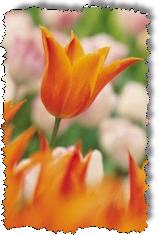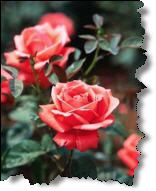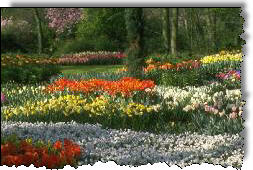

|
Here are some basic flower gardening tips to think about. First, let's look at the different types of flowers. Consider how long you want your flowers to survive in the garden. Your flower garden ideas will unfold from there!
Annual Flowers
Annuals last one season and die out. This means these flowers have to be replanted every year. The advantage here is you can always change your garden plans the next year. Annual blooms provide a glorious array of color during their blooming season... no garden is complete without them!
Use these blooms in gardens, and as edgings and borders. Mixing annual flowers in among perennials and bulbs fills the gaps in a garden while it extends the flowering time. Annuals are excellent flowers for hanging baskets and container gardening, too.
Perennial Flowers
Perennial flowers come back year after year. The advantage here is you never need to replant them. However, short of transplanting them all, you are "locked-in" to your original garden design.
First, choose perennial flowers based on their tolerance of sun or shade. Aim your garden plans towards getting different perennials to bloom at a certain time and place in your garden. Also, choose the height of flowers for each spot in your garden... from low creepers to tall flowers reaching 6 to 10 feet.
Flower Bulbs
 When you add bulbs to your flower
garden plans, you get two great benefits (besides their spectacular blooms):
When you add bulbs to your flower
garden plans, you get two great benefits (besides their spectacular blooms):
-
Flower bulbs come back each year, after being dormant over winter months. Many bulbs are hardy and reliable, meaning you can "forget" about them... and they'll present themselves sure enough every spring.
-
Just like perennials, you can plant bulbs according to flowering times for a constant array of color. For a garden that blooms all season, plant a number of bulb types with succeeding flowering times.
Intersperse flower bulbs into several types of blooms, ground covers, shrubs, and along sidewalks or garden paths. Be creative and plant them in patterns!
Roses
 A
rose garden is the crowning jewel for most home gardeners. While no garden is
complete without roses, a rose garden is complete in itself. No other flower has
passed the tests of time and preference with such grace. A formal rose garden is
breathtaking. A country home adorned by roses has incredible charm.
A
rose garden is the crowning jewel for most home gardeners. While no garden is
complete without roses, a rose garden is complete in itself. No other flower has
passed the tests of time and preference with such grace. A formal rose garden is
breathtaking. A country home adorned by roses has incredible charm.
Is there an art to growing a rose garden? Sure there is. But we make it easy, and show you step-by-step everything you'll ever need to know. You'll be surprised how fun roses can be when you learn rose gardening from us with our Easy Book series, Easy Rose Gardening.
Get our FREE practical guide to dealing with pests, diseases and disorders that commonly affect lawns, vegetables, trees and garden flowers. Sign up for 101 Gardening Tips: A - Z of Pests, Diseases and Disorders. Completely FREE!
For more great pointers about types of flowers such as annuals and perennials, plus more flower gardening tips, check out the facts and suggestions from our flower guide.
Built by Champion Promotions Powered by SiteSell
www.lawn-and-gardening-tips.com
Copyright © by Robert Mosse, All rights reserved.
 Design
your garden plans with your flowers' natural blooming in mind. Plan well, and
the result is a flower garden that blooms from spring to frost in vibrant color.
Design
your garden plans with your flowers' natural blooming in mind. Plan well, and
the result is a flower garden that blooms from spring to frost in vibrant color.